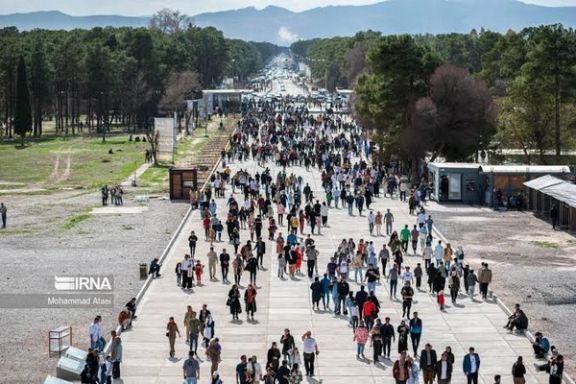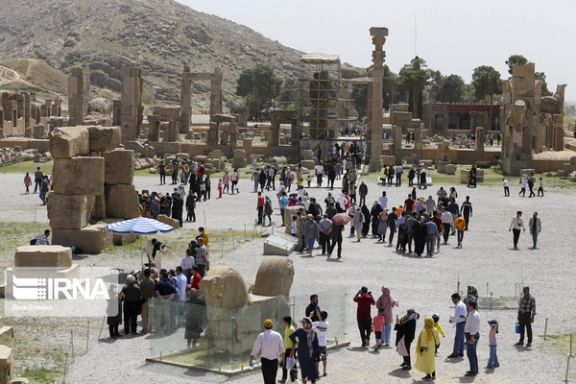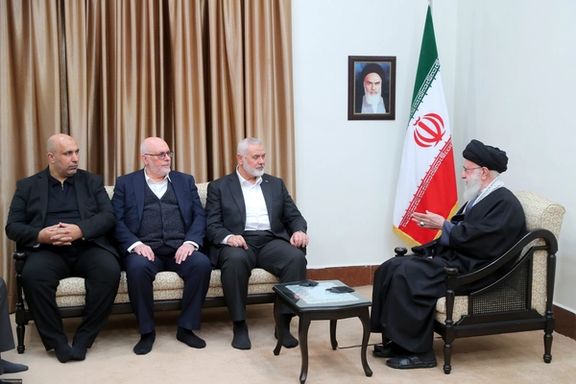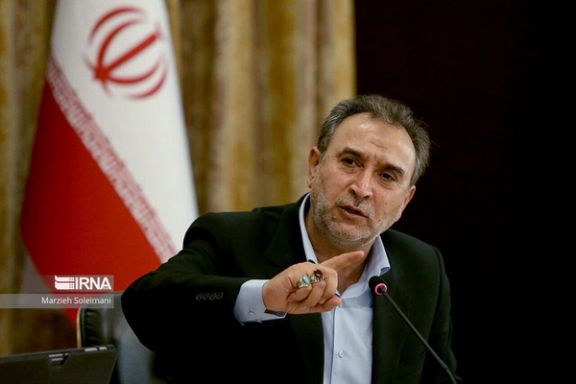Controversy Surrounds Arrest Of US-Iranian Citizen Sereen Badiei

The arrest of Sereen Badiei, a US-Iranian dual national in Iran, who calls himself a "prince," has stirred controversy in Iranian social media and news websites worldwide.

The arrest of Sereen Badiei, a US-Iranian dual national in Iran, who calls himself a "prince," has stirred controversy in Iranian social media and news websites worldwide.
Badiei, also known as Sereen Curtis, and calling himself as Prince Sereen, has been detained in Alborz province, on charges of "insulting sanctities," Iran's Judiciary confirmed.
"After informing the accused of the charges and issuing a temporary detention order, following the introduction to prison, he was handed over to the officer for further investigation," stated Mehdi Keshtdar, CEO of Mizan News Agency, affiliated with Iran's Judiciary.
Born in Tehran in 1973, Sereen, 51, who had been residing in the United States, faced criticism for his controversial videos targeting Islam, Shiite religion, the Quran, and the Iranian government.
The arrest has triggered varied reactions with some social media users expressing concerns about his fate and potential severe sentencing given his history.
"It doesn't matter to anyone that Sareen was arrested. Everyone makes jokes and laughs at him, as if he isn't an Iranian whose life matters…," lamented one user.
In contrast, supporters of the government welcomed his detention.
Demanding his execution, user Sadaf labeled Sereen as the perpetrator of insulting Muslim sanctities, while others accused him of immorality.
However, some users viewed Sereen's arrest as a ploy by the Iranian government to divert attention from pressing issues such as the exchange rate, inflation, and financial corruption allegations.
Iran frequently detains individuals holding Western passports and leverages them as bargaining tools. The resurgence of dual national hostages has come to attention following a recent Qatar-mediated agreement to release $6 billion in Iranian funds held in South Korea, in exchange for the freedom of five US citizens.
This has sparked accusations that the Biden administration is engaging in a risky strategy that could incentivize further hostage-taking of dual nationals overseas.

This year, the Islamic month of Ramadan coincided with the ancient Persian celebration of New Year (Norouz). Urged by authorities to follow fasting traditions, Iranians were asked not to travel during Ramadan.
But, despite these calls, the Iranian populace took advantage of the one-week Norouz holiday, starting on March 20, and visited the country’s ancient and cherished national monuments.
Authorities reported a staggering 2.8 million Iranians flocking to the nation's museums and historical sites during the New Year holidays.
Among these destinations, the tomb of the revered Persian poet Hafez in Shiraz witnessed the most substantial influx, attracting approximately 200,000 visitors. The ancient city of Persepolis received approximately 140,000 visitors, while the historic royal complex of Sa’dabad Palace in Tehran welcomed around 75,000 visitors.
Pictures and videos showcasing the 5-kilometer queue of cars entering Persepolis, along with the sizable gathering of Iranians at the nearby ancient archaeological site of Naqsh-e Rostam, circulated on local websites.

Some estimates suggest nearly 10,000 people were in Persepolis and 30,000 people at the tomb of Hafez to mark the exact moment of the Spring equinox – marking the beginning of the new year. In several provinces people gathered around traditional bonfires to dance and sing and celebrate.
On the flip side, a senior Iranian cleric has reported that two-thirds of the country's 75,000 mosques have been shut down.
The mosques of major cities may attract a small crowd during communal prayers – only at one time of the day. Morning and afternoon prayers are often not held. During the month of Ramadan, mosques in Muslim-majority countries typically witness a surge in attendance.
But, in Iran prayers have retreated to the privacy of people’s homes – reflecting a trend where people prefer not to show off their religiosity.
Notably, the list of the most visited places doesn't even include iconic and breathtaking mosques such as the Amir Chakhmaq Mosque in Yazd or the Shah Mosque in Esfahan.
While government propaganda outlets claim 5 million pilgrims entered Khorasan Razavi province, no photographic evidence depicting these purported millions of people or the vehicles transporting them have been published.
This figure is misleading as it implies that all those entering Khorasan Razavi province are pilgrims, whereas many visit the province to reunite with family rather than for pilgrimage. The photos accompanying these reports depict tens of thousands of pilgrims, not millions as claimed.
Three competing visions
What vision does the above social trend draw for the future of Iran? In what direction is the country heading? Despite enduring political and social upheavals, the main highways shaping Iran's future trajectory are rooted in Iran-centered nationalism, Islamism, and ethnocentrism.
None of these three can be eliminated, yet current developments vividly illustrate the path of nationalism over the other two.
Even religious reformers no longer believe that Islamism will remain the dominant vision. Ethnocentrism is present but not dominant. However, Iran-centric nationalism, once marginalized during the dominance of Islam-oriented discourse from the 1980s to the 2000s, has emerged as a serious and formidable contender against both Islam-oriented and ethnocentric perspectives in recent years.
Among these three paths, the Islam-centered one has been thoroughly explored in the past, with its failures and disastrous outcomes evident for Iranians to see clearly. The effort of the Islamists was to realize this path in such a way that no one in Iran could even think of the other two. The Islamists wanted to build their ideal society without a rival by realizing religious totalitarianism and stopping the resistance of Iranian citizens against repressive and Islamist-oriented social engineering.
The Iran-centered roadmap was implemented over five decades by a group of patriotic people during the Pahlavi era and brought Iran security, prosperity, development, tolerance, and credibility in the world.
The only unexplored path remaining is ethnocentrism. The challenge with this approach is that, aside from advocating for self-government and local rule, it has not put forth a comprehensive vision for the nation-state. For this reason, individuals who do not align with the framework of ethnicities or have moved beyond ethnic affiliations do not see this vision as their salvation.
Since 2018, the Islam-oriented and ethno-oriented perspectives have not appeared much even in the scene of public protests. The slogan "Fundamentalist, reformist! It's over" – which permeated the political landscape of the country and was even somewhat echoed by politicians of the Islamic Republic in various forms – marked a pivotal moment in the decline of the Islam-oriented path in the nation. The ruling Islamists even beat the drum of military ambitions and missiles more than the elements of the Islam-oriented path. By using the combination of "Iranian-Islamic" for their programs, they attempt to make it Iran-centric. However, the Sharia-centric path and the lifestyle of the Shia clergy are so central in their programs that they leave no room for Iran.
Nationalist or patriotic movements, which the left falsely identifies as fascist and racist, are gaining momentum worldwide. They seek to liberate their nations from the influence of indoctrination, radical ideologies, identity politics, anarchism, and cultural relativism – ideologies that threaten the decline of Western civilization. Today, Iranian nationalism is focused on the salvation of Iran by eliminating Islamist policies.
Due to its compatibility with the lifestyle of the majority, social tolerance, development-oriented approach, and openness to the West, the Iran-centered path has garnered the greatest support from the common people in the streets and markets.
The slogan "Reza Shah, Rest in Peace" used in street protests, invoking the memory of the first King of the Pahlavi dynasty in Iran, effectively encapsulates this vision.

The Iran-backed Houthi terror group has renewed warnings against countries participating in attacks on its infrastructure amid US-led strikes against the group’s Red Sea blockade.
Mohammed Ali al-Houthi, a member of the group’s Supreme Political Council, issued the threats in an interview with Al-Masirah television channel, denouncing US pressure on other nations to join the 20-plus nation coalition against Yemen formed in response to its Red Sea blockade.
"We renew our warnings that any country that would act against our country would make its interests a legitimate target for us," al-Houthi stated, describing the US strikes as "arrogant" and "unjustified actions."
Al-Houthi also cautioned Saudi Arabia specifically against aiding the joint US-British aggression, warning that it would become a target for the rebel group which has been in a war with a Saudi-led coalition for almost a decade.
The Houthis have carried out dozens of missile and drone attacks on ships passing through the Red Sea, which they claim are linked to Israel. Recently, a Chinese-owned oil tanker was targeted, though no casualties were reported.
Despite the attacks, assurances were given to China and Russia that their ships would not be targeted, according to al-Houthi.
The US and UK have intensified strikes against Houthi positions to deter further attacks in the Red Sea, with recent strikes targeting underground storage facilities controlled by the rebels.
The blockade was launched in November on the orders of Iran’s supreme leader, in solidarity with terror group Hamas’s war against Israel, launched on October 7.
However, the blockade aiming to target Israeli linked vessels has since seen attacks on multiple international ships passing through the critical trade route.

Hamas leader Ismail Haniyeh during his visit to Tehran met with Iran's Supreme Leader Ali Khamenei, who is a staunch supporter of Islamist groups among Palestinians and in regional countries.
"The Islamic Republic of Iran will not hesitate in supporting the cause of Palestine and the oppressed and resilient people of Gaza," Khamenei said during his meeting with Haniyeh.
The real reason for such trips rarely leaks to media, but Iran has backed Hamas in the nearly six-month war with Israel, which is still reeling from the US decision not to veto the UN Security Council resolution demanding an immediate ceasefire. This is Haniyeh's second visit to Iran since Hamas invaded Israel, killing 1,200 mostly civilians and taking 250 hostages in October.

Hamas welcomed the resolution but said the ceasefire needs to be permanent. Iranian officials lauded it as “a positive step” with foreign ministry spokesman Nasser Kanaani saying, “A more important step is effective action for its implementation."
Haniyeh said in Tehran on Tuesday that Hamas is transitioning into a new phase of war with Israel. “We are in the process of passing through a historic phase in the struggle against the Zionist regime, with the Al-Aqsa Storm being the turning point,” he said during his joint press conference with Foreign Minister Hossein Amir-Abdollahian. Hamas dubs its attack on Israel as the Al-Aqsa Storm.
“Iran stands at the forefront of supporting the cause and people of Palestine,” Haniyeh added. “I extend special thanks to the Supreme Leader of the Islamic Revolution of Iran, the President of Iran, and the people of Iran.”
In March 2022, Haniyeh revealed that the Islamic Republic paid a total of $70 million to Hamas to help it develop missiles and defense systems. During an interview with Al-Jazeera, Haniyeh said different countries help in financing the group, but Iran is the biggest donor.
Last May, Iran International reported that Hamas pressured the Islamic Republic into inviting its leader, Ismail Haniyeh, to Tehran hoping to get financial support. Our sources said that although the Islamic Republic continues to provide financial aid to Hamas despite its own economic situation, Tehran was not satisfied with the performance of the group against Israel. This was only a few months before Hamas launched the October 7 attack.
While Hezbollah is by far Iran's richest and most powerful proxy, the combined funds of the Palestinian Islamic Jihad Movement, Hamas and the Popular Front for the Liberation of Palestine are enormous, Hamas and Islamic Jihad receiving a large share of Tehran’s aid. In 2018, US President Donald Trump’s special Middle East envoy Jason Greenblatt, who recently visited Israel's communities on the Gaza perimeter and toured the terror tunnel the IDF exploded, claimed Iran provided $100 million annually to Hamas compared to $700m annually to Hezbollah.

During his press conference in Tehran, Haniyeh stated that UN resolution was an indication that Israel is globally isolated. He said that Israel is "losing political cover and protection even in the Security Council" and "the US is unable to impose its will on the international community".
Also on Tuesday, Israel said it is recalling its negotiating team from Qatar after Hamas rejected its latest offer in talks for a hostage deal and truce.
According to Prime Minister Benjamin Netanyahu’s office, Hamas’s decision to reject a US-brokered compromise is “clear proof it is not interested in continuing talks, and a sad testament to the damage caused by the UN Security Council resolution.”
The Israeli government accuses Hamas of retreating to its “extreme demands” including a complete end to the war and full IDF withdrawal from Gaza. “Israel will not cave to Hamas’s delusional demands.”
A diplomatic official quoted by Hebrew-language media said Hamas demanded that Gazans be given carte blanche to return to the north of the Strip and did not even address a hostage release. “There is no one to talk to on the other side and the Israeli negotiating team has nothing to do in Qatar,” the source is quoted saying according to the Times of Israel.

Iran has reiterated its ultimatum to Kuwait concerning the disputed Arash gas field.
Iran's vice president for legal affairs, Mohammad Dehghan, emphasized Iran's position, stating, "We will not grant unilateral extraction rights without considering our country's interests to any country."
He stated, "Under no circumstances will the Islamic Republic of Iran retreat from its 'acquired right' in the Arash gas field."
The Arash field, also known as Durra or Dorra by Saudi Arabia and Kuwait, has become a focal point of contention. In 2022, a Kuwaiti-Saudi Arabian development agreement concerning the field drew criticism from Iran, which claims a stake in it. Durra is estimated to hold around 20 trillion cubic feet in proven reserves.
Discovered in 1967, the offshore field boasts substantial reserves, including approximately 310 million barrels of oil and significant gas reserves.
Saudi Arabia and Kuwait's recent statements regarding the energy reserve field have intensified tensions, with demands for Iran to demarcate its maritime borders in the region.
In 2001, Iran deployed drilling equipment into the field, leading Kuwait to file complaints with international organizations. Subsequently, Iran halted its preparations for exploitation, and Kuwait also put on hold its plans in the region with Saudi Arabia.
Iran's access to international companies for the development of its oil and gas fields has been hampered by sanctions over its nuclear program. As a result, Iran has turned to allies like Russia to advance its oil field projects. China remains its biggest customer.

Plainclothes agents attacked several Norouz travelers in the southeastern city of Zahedan, seizing their mobile phones near the Makki mosque on Monday.
The mosque has been the center of anti-regime protests and gatherings within the past months with Mowlavi Abdolhamid, the outspoken Sunni leader delivering weekly sermons.
Additionally, the windows of several travelers' vehicles were shattered in what appears to be a coordinated effort.
Furthermore, three members of Zahedan's Makki Mosque, who were assisting Norouz travelers, reportedly faced summons and threats from security forces.
The incidents, as outlined by the Halvash rights group and echoed by Baluch activists, are perceived as tactics aimed at instilling fear and discouraging attendance at the Makki Mosque, particularly to prevent interactions with Mowlavi Abdolhamid.
Amid the atmosphere of tension and intimidation, Hossein Ronaghi, a human rights activist and former political prisoner, engaged in a conversation with Mowlavi Abdolhamid at Zahedan's Makki Mosque on Monday. Ronaghi was invited as a guest to Abdolhamid’s reception at the mosque.
Abdolhamid, known for his outspoken criticism of the Iranian regime, continues to advocate for justice and freedom despite facing opposition.
The developments unfold against the backdrop of ongoing struggles faced by Baluch Iranians, especially in Sistan-Baluchestan Province, where minority communities endure repercussions for their participation in the 2022 protests.
The province blighted by poverty and predominantly Sunni Baluch, has witnessed a heavy-handed response from the regime, with dissenters facing punishments, including execution.